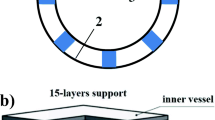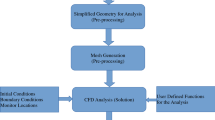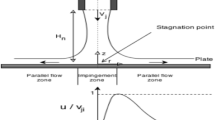Abstract
Safe storage and transportation of liquid oxygen (LOX) are critical for many engineering, medical, and defense applications. Double-walled, vacuum-insulated cryogenic tanks are commonly used, but they require supports that minimize heat transfer while bearing mechanical stresses. This study examines a novel polyamide-steel composite support for cryogenic tanks using COMSOL simulations. The significance lies in improving storage by reducing heat flux to LOX. The study also evaluates the effects of dynamic loading, resulting from mechanical shocks three times larger than the mass of the inner shell carrying LOX, applied to the ends of the internal supports. The significant contributions of this research lie in two main areas. Firstly, the study demonstrates the advantages of the new support design, particularly its enhanced ability to minimize heat transfer from the external environment to the cryogenic tank, thereby contributing to improved temperature control and safety. Secondly, the developed composite supports exhibit superior heat transfer characteristics, displaying efficiency in both static and dynamic loading conditions. Results demonstrated that the composite support reduced heat transfer compared to conventional designs under static and dynamic loads. This new support design enables safer LOX storage by limiting temperature increases. The coupled thermal–mechanical modeling methodology provides an effective tool for optimizing support designs in cryogenic systems.













Similar content being viewed by others
Abbreviations
- \(d\) :
-
Internal vessel diameter (m)
- \({R}_{\mathrm{k}}\) :
-
Inside knuckle radius (m)
- \({R}_{\mathrm{c}}\) :
-
Inside crown radius (m)
- \(z\) :
-
Inside dish depth (m)
- \({L}^{0}\) :
-
Tan-tan length (m)
- \({V}_{\mathrm{c}}\) :
-
Volume of semielliptical head (\({\mathrm{m}}^{3}\))
- \({V}_{\mathrm{s}}\) :
-
Volume of the cylindrical shell (\({\mathrm{m}}^{3}\))
- \(E\) :
-
Modulus of elasticity (Pa)
- \(\mathrm{\vartheta }\) :
-
Poisson ratio
- \({S}_{\mathrm{a}}\) :
-
Allowable stress (Pa)
- \(k\) :
-
Thermal conductivity (W m−1 K−1)
- \({q}_{\mathrm{conv}}\) :
-
Convection heat transfer rate (W)
- \({T}_{\infty 1}\) :
-
LOX temperature (\(\mathrm{K}\))
- \({T}_{\infty 2}\) :
-
Ambient temperature (\(\mathrm{K}\))
- \({h}_{1}\) :
-
Convective heat transfer coefficient OF LOX (\( {\text{W}}\;{\text{m}}^{{ - 2}} {\text{K}}^{{ - 1}} \))
- \({h}_{2}\) :
-
Convective heat transfer coefficient OF Ambient (\( {\text{W}}\;{\text{m}}^{{ - 2}} {\text{K}}^{{ - 1}} \))
- \(p\) :
-
Internal pressure (Pa)
- \(L\) :
-
Length of the inner shell (m)
- \(t\) :
-
Wall thickness of inner vessel (m)
- \({t}_{\mathrm{h}}\) :
-
Wall thickness of inner semielliptical head (m)
- \(\rho \) :
-
Mass density (kg m-3)
- \({q}_{\mathrm{cond}}\) :
-
Conductive heat flux (\( {\text{W}}\;{\text{m}}^{{ - 2}} \))
- \({e}_{\mathrm{w}}\) :
-
Weld efficiency
References
Timmerhaus KD, Flynn TM. Cryogenic process engineering. Springer Science & Business Media; 2013.
Wu Z, Li S, Liu M, Wang H, Wang Z, Liu X. Study on liquid oxygen compatibility of bromine-containing epoxy resins for the application in liquid oxygen tank. Polym Adv Technol Wiley Online Libr. 2016;27:98–108.
Li S, Li J, Cui Y, Ye J, Chen D, Yuan Y, et al. Liquid oxygen compatibility of epoxy matrix and carbon fiber reinforced epoxy composite. Compos Part A Appl Sci Manuf. 2022;154:106771.
Nomura T, Ikeda A, Gen M, Matsuo A, Kindo K, Kohama Y, Matsuda YH, Zherlitsyn S, Wosnitza J, Tsuda H, Kobayashi TC. Physical properties of liquid oxygen under ultrahigh magnetic fields. Phys Rev B. 2021;104(22):224423.
Sass JP, Fesmire JE, Nagy ZF, Sojourner SJ, Morris DL, Augustynowicz SD. Thermal performance comparison of glass microsphere and perlite insulation systems for liquid hydrogen storage tanks. AIP Conf Proc. American Institute of Physics; 2008. pp. 1375–82.
Chu X, Huang R, Yang H, Wu Z, Lu J, Zhou Y, et al. The cryogenic thermal expansion and mechanical properties of plasma modified ZrW2O8 reinforced epoxy. Mater Sci Eng A. 2011;528:3367–74.
Chen H, Yang G, Wu J. A multi-zone thermodynamic model for predicting LNG ageing in large cryogenic tanks. Energy. Elsevier; 2023;p. 128503.
Ratnakar RR, Sun Z, Balakotaiah V. Effective thermal conductivity of insulation materials for cryogenic LH2 storage tanks: a review. Int J Hydrog Energy. 2023;48:7770–93.
Monkam LK, von Schweinitz AG, Friedrichs J, Gao X. Feasibility analysis of a new thermal insulation concept of cryogenic fuel tanks for hydrogen fuel cell powered commercial aircraft. Int J Hydrog Energy. 2022;47:31395–408.
Puthettu Muraleedharan S, Joseph J, Chollackal A, Peter J, Agarwal DK. Experimental investigation of thermal stratification in cryogenic tank subjected to multi-species bubbling. J Therm Anal Calorim. 2023;148:2949–59.
Vishnu SB, Kuzhiveli BT. Mathematical modeling of thermal stratification in a double wall cryogenic propellant tank with different insulations using one-dimensional flow over vertical plate approximation. Cryogenics. 2022;121:103393.
Gorbachev SP, Semenov VY, Klebleev TI. Process flow diagrams of cryogenic double-wall tanks for LNG storage. Chem Pet Eng. 2021;57:555–60.
Flynn T. Cryogenic engineering, revised and expanded. CRC Press; 2004.
Fesmire JE, Johnson WL. Cylindrical cryogenic calorimeter testing of six types of multilayer insulation systems. Cryogenics. 2018;89:58–75.
Deng B, Yang S, Xie X, Wang Y, Bian X, Gong L, et al. Study of the thermal performance of multilayer insulation used in cryogenic transfer lines. Cryogenics. 2019;100:114–22.
Jiang W, Sun P, Li P, Zuo Z, Huang Y. Transient thermal behavior of multi-layer insulation coupled with vapor cooled shield used for liquid hydrogen storage tank. Energy. 2021;231:120859.
Liu Z, Feng Y, Lei G, Li Y. Thermal physical process in a liquid oxygen tank under different sloshing excitations. Int Commun Heat Mass Transf. 2020;117:104771.
Joseph J, Agrawal G, Agarwal DK, Pisharady JC, Kumar SS. Effect of insulation thickness on pressure evolution and thermal stratification in a cryogenic tank. Appl Therm Eng. 2017;111:1629–39.
Palaiah SS, Basha H, Reddy GJ. Magnetized couple stress fluid flow past a vertical cylinder under thermal radiation and viscous dissipation effects. Nonlinear Eng De Gruyter. 2021;10:343–62.
Gong S, Zhao S, Chen X, Liu H, Deng J, Li S, et al. Thermoplastic polyamide elastomers: synthesis, structures/properties, and applications. Macromol Mater Eng. 2021;306:2100568.
Ali U, Karim KJBA, Buang NA. A review of the properties and applications of poly (methyl methacrylate)(PMMA). Polym Rev. 2015;55:678–705.
Schulz U. Review of modern techniques to generate antireflective properties on thermoplastic polymers. Appl Opt. 2006;45:1608–18.
Cella RJ. Morphology of segmented polyester thermoplastic elastomers. J Polym Sci Polym Symp. 1973. https://doi.org/10.1002/polc.5070420224.
Ma J. The influence of processing conditions on the mechanical properties of poly (acrylonitrile-butadiene-styrene)/poly (methyl methacrylate)(ABS/PMMA) blends. J Macromol Sci Part B. 2023;62:153–71.
Zhang J, Hirschberg V, Rodrigue D. Mechanical fatigue of polymer foams-a review. Polym Rev. 2023. https://doi.org/10.1080/15583724.2023.2228874.
Jiang C, Ma L. Polyamide 6-based thermoplastic vulcanizate for thermostability: an experimental and theoretical investigation. J Appl Polym Sci. 2022;139:51718.
He F-M, Liu B-W, Chen L, Guo D-M, Ding X-M, Xiao Y-F, et al. Novel polyamide 6 composites based on Schiff-base containing phosphonate oligomer: high flame retardancy, great processability and mechanical property. Compos Part A Appl Sci Manuf. 2021;146:106423.
Wang C, Guo L, Liu Z, Zhang Y, Li Z. Unsteady flow analysis regarding stall flow and rotating cavitation in the first-stage of a multistage LNG cryogenic submerged pump. Cryogenics. 2023;129:103546.
Choi D-J, Oh J-T, Jung J-H, Cho J-R. Weldment design of supports for cryogenic storage tank considering insulation. J Adv Mar Eng Technol. 2008;32:131–6.
Lisowski F, Lisowski E. Thermal and mechanical analysis of the internal support for LNG cryogenic road tanker. E3S Web Conf. EDP Sciences; 2019. p. 1020.
Czyżycki W. Modeling of heat flow through multilayer internal supports of cryogenic vessels. Czas Tech; 2015.
Lisowski KŁE, Czyżycki W, Łazarczyk K. Using of polyamide in construction of supporting blocks of cryogenic tanks on example of LNG container. Arch Foundry Eng. 2010;10:81–6.
Lisowski E, Czyżycki W, Łazarczyk K. Simulation and experimental research of internal supports in mobile cryogenic tanks. Czas Tech Mech. 2010;107:175–84.
Kumar M, Reddy GJ, Kumar NN, Bég OA. Application of differential transform method to unsteady free convective heat transfer of a couple stress fluid over a stretching sheet. Heat Transf Res. 2019;48:582–600.
Reddy GJ, Kumar M, Rani HP. Study of entropy generation in transient hydromagnetic flow of couple stress fluid due to heat and mass transfer from a radiative vertical cylinder. Pramana. 2019;93:1–14.
Reddy GJ, Hiremath A, Kumar M, Bég OA, Kadir A. Unsteady magnetohydrodynamic couple stress fluid flow from a shrinking porous sheet: variational iteration method study. Heat Transf. 2022;51:2219–36.
Basha H, Reddy GJ, Narayanan NSV, Sheremet MA. Analysis of supercritical free convection in Newtonian and couple stress fluids through EOS approach. Int J Heat Mass Transf. 2020;152:119542.
Norouzifard V, Hosseini SM, Alizadeh E. Investigating the effect of metal-polymer internal support on reducing the heat transfer rate of mobile cryogenic vessels. Heat Mass Transf. 2021;57:269–82.
Lisowski F, Lisowski E. Design of internal supports for double-walled liquefied natural gas road tanker. Heat Transf Eng. 2021;43:238–47.
Callister Jr WD. Materials science and engineering an introduction; 2007.
Sweet JN, Roth EP, Mjij M. Thermal conductivity of Inconel 718 and 304 stainless steel. Int J Thermophys. 1987;8:593–606.
Barderas AV, Rodea B. How to calculate the volumes of partially full tanks. Proc Int J Res Eng Technol; 2016. pp. 2–7.
BaldevBhai PP, Shah R. Design and Optimization of Cryogenic Storage Vessel. Citeseer; 2014.
Bpvc-Iid A. ASME boiler and pressure vessel code section II-materials, Part D-properties (Customary). New York: ASME; 2015.
Landel RF, Nielsen LE. Mechanical properties of polymers and composites. CRC press; 1993.
Muhammed RK V, Basha H, Reddy GJ, Shankar U, Bég OA. Influence of variable thermal conductivity and dissipation on magnetic Carreau fluid flow along a micro-cantilever sensor in a squeezing regime. Waves in Random and Complex Media. Taylor & Francis; 2022, pp. 1–30.
Saffari PR, Thongchom C, Jearsiripongkul T, Saffari PR, Keawsawasvong S, Kongwat S. Thermo-vibro-acoustic analysis of pavement under a harmonically rectangular moving load. Int J Thermofluids. 2023;20:100409.
Saffari PR, Thongchom C, Jearsiripongkul T, Saffari PR, Keawsawasvong S, Kongwat S. Porosity-dependent wave propagation in multi-directional functionally graded nanoplate with nonlinear temperature-dependent characteristics on Kerr-type substrate. Int J Thermofluids. 2023;20:100408.
Kosky P, Balmer R, Keat W, Wise G. Chapter 12 - Mechanical Engineering. In: Kosky P, Balmer R, Keat W, Wise GBT-EE (Third E, editors. Boston: Academic Press; 2013. pp. 259–81. https://www.sciencedirect.com/science/article/pii/B9780124158917000121.
Author information
Authors and Affiliations
Corresponding author
Ethics declarations
Conflict of interest
The authors declare that they have no known competing financial interests or personal relationships that could have appeared to influence the work reported in this paper.
Additional information
Publisher's Note
Springer Nature remains neutral with regard to jurisdictional claims in published maps and institutional affiliations.
Rights and permissions
Springer Nature or its licensor (e.g. a society or other partner) holds exclusive rights to this article under a publishing agreement with the author(s) or other rightsholder(s); author self-archiving of the accepted manuscript version of this article is solely governed by the terms of such publishing agreement and applicable law.
About this article
Cite this article
Ghadimi, M., Barzegari, M.M. A numerical transient thermomechanical modeling of the metal-polyamide internal supports for cryogenic vessels. J Therm Anal Calorim 148, 11917–11927 (2023). https://doi.org/10.1007/s10973-023-12469-7
Received:
Accepted:
Published:
Issue Date:
DOI: https://doi.org/10.1007/s10973-023-12469-7




